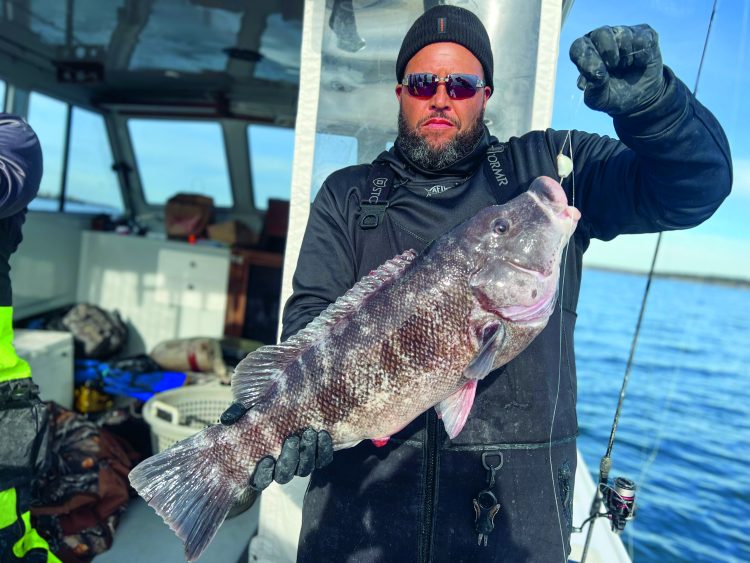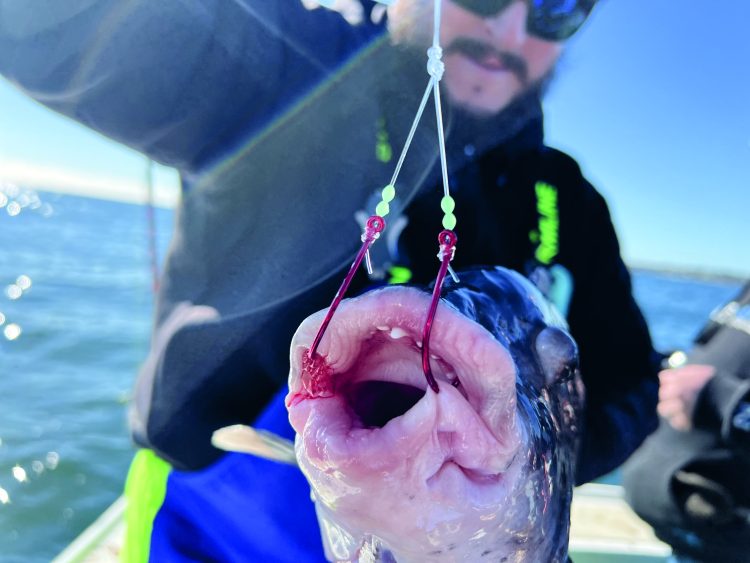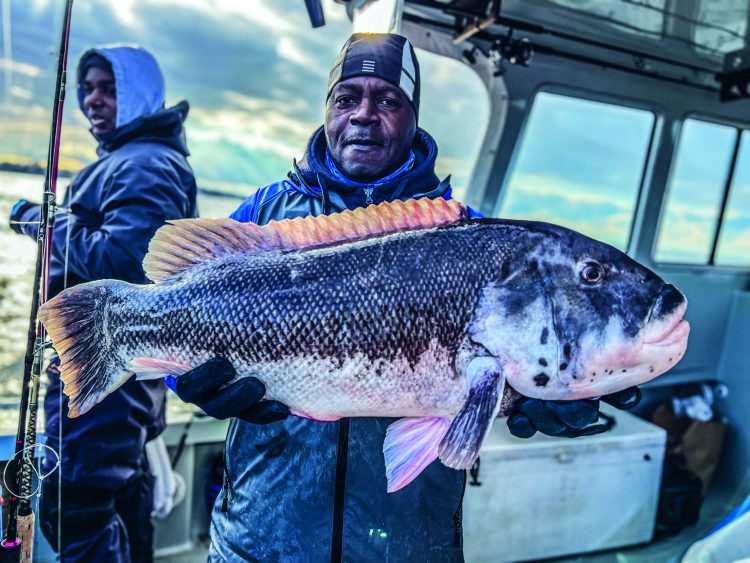Tautog Jigs vs. Rigs
Understand the pros and cons of both tog presentations to get more bites this fall.

Whether you’re a seasoned tog pro or a beginning blackfisherman, the words “tog jig” have undoubtedly been drilled into your brain. This relatively simple method of fishing has exploded in popularity over the past 10 to 15 years. When I was a teenager and just getting into blackfishing, I had no idea what tautog jigs were. Everyone I knew was fishing a simple bottom rig with heavy lead to keep it buried in the rocks.
For most of us, togging was a way to scratch the fishing itch a few more times before season’s end. I could count the number of boats togging by late October on one hand since most people wrapped the season up after Halloween. Fast-forward 20 years and my local Newport, Rhode Island, waters now look like parking lots with the sheer number of boats out chasing blackfish; its popularity has also exploded down the Northeast and Mid-Atlantic coasts. With that came the birth of the light tackle, sport-minded tog jig. For most hardcore toggers, jigging is the method of choice; at times, however, conditions and certain scenarios don’t allow for it so it’s crucial to have a balanced skillset between fishing both the jig and the rig.
Choosing Tautog Jigs
If you’re new to using tautog jigs, choosing the right one can seem daunting. There are dozens of styles, colors, and sizes to choose from. My advice is to try a variety and see which style best suits you. I look for a few key components in my tog jigs. It must have a heavy-gauge wire, minimum 2X strength, with a round wide-gap or sickle bend. I prefer jigs using either wide-gap J hooks or live-bait hooks.
Use a jig with the sharpest hook you can find. (I’m partial to Owner, Matzuo, VMC, or Mustad brand hooks.) The perfect hook point will hold its edge for a while, even on the hardest bottom, but can also be sharpened when needed. The shape of my jig can vary if it checks off three important boxes: a minimal-drag design, a stable base, and an upward-facing hook orientation, though banana- and boxing-glove-style jigs work best for me. I always fish as light as possible, so it’s very important that my jig is sleek and able to get to the bottom quickly with minimal resistance from water current.
I want the hook to sit perpendicularly, or face slightly upward, when lying directly on the bottom. I try to avoid jig designs where the hook and jig can easily lie on its side or face the bottom. I want minimal transfer of energy wasted from bite to hookset. A perfect jig gets to the bottom with ease, has a stable base to avoid rolling, features a very sharp and strong hook, and face slightly upward for optimal presentation and quick hooksets.
Color is the last thing I look for because I don’t think it makes much difference. Blackfish are naturally inquisitive and will show interest in glow and bright colors at certain times; however, natural crab patterns also produce well. In my opinion, fish are attracted to the baits tipped on your tautog jigs far more than their color, but it’s always a good idea to have a variety. Lastly, find a jig that has been painted properly with a hard and durable finish to minimize excessive chipping and cracking.

Tips for Using Tautog Jigs
While picking the right jig is important, it does little good if you don’t know how to fish it because a jig has major advantages over a traditional rig. Most jigging setups are lighter tackle, more sensitive, more responsive, and less prone to hangups. As a charter captain, I fish with anglers who have varying ability levels. Some jig the entire day and out-fish the whole boat, while others won’t even unpack a jigging rod. The bite is entirely different and can take some practice and adaptation to understand the intricacies.
Tautog jigs are meant to be fished with finesse. Most times, I tip my jig with a half crab (legs cut off) or very small whole crabs. Minimizing the drag created from any added weight is crucial. I want the bait to be taken in one swipe with the jig rather than picked apart by dozens of hits.

Ideally, I don’t want my jig to bounce straight up and down on the bottom. I prefer the bait suspended freely just off the bottom, fluttering slightly in the current as naturally as possible. When a sizeable tog decides to take the jig, nine times out of ten, they will bite the entire jig and swim away with it, pulling it away from smaller competing fish. This is the telltale blackfish jig bite: your line will go slack or move ever so slightly, which is when to set the hook. Patience is crucial. You often must weed through smaller, pesky bites until you get the winning bite, which is when the entire hook is in the fish’s mouth. If you can learn to differentiate between the two distinct bites, you’ll catch more quality blackfish on tautog jigs.
Tackle and Leader for Tog Jigs and Rigs
With the goal of always using the lightest jig possible with a natural presentation, ensure you use the right size line and leader. The larger the line and leader diameter, the more drag you will have through the scope of your line.
I recommend fishing 15- to 30-pound-test braided line with a 30- to 40-pound-test fluorocarbon leader. I never use terminal tackle and always tie my leaders at a 6- to 8-foot length, tied directly via modified FG knot. Your line needs to be thin enough to slice through the water current, but strong enough to turn the head of a big tog when it tries to bury itself in structure. I fish my jig spinning reels with heavy drag.
Trusting your knots and the condition of your line is critical. If my leader comes up with even the slightest fray, I replace it and even cut back 10 to 15 feet of main line and retie. I want my connections to be strong and dependable. My main goal is to pull the larger fish up and out from the danger zone. There is a small window after setting the hook on a big tog when you can lift and turn the fish before it fully realizes it’s hooked and tries to retreat to the rocks or wreck it came from.
If you fish in an area that’s known to have a lot of tide or you’re fishing on a moon cycle (or fishing very deep), tautog jigs just won’t do the job. Even if you have perfect jigging conditions, the fish might prefer a rig with a lazier presentation tight to the bottom. If very big fish move in and I want to use large baits, I prefer the rig. I always like it when a charter group has a mix of the two methods so I can see exactly what type of bite to expect.
My rig rod is usually a conventional with a stout backbone. I fish 40- to 50-pound braided line with fluorocarbon leader that’s anywhere from 50- to 80-pound test, depending on how sticky the bottom is. I prefer fluorocarbon leader for my rigs due to its abrasion resistance, rigidity, and transparency.
I keep things simple with the rig. I almost exclusively fish a snafu-style but will also fish a slider rig and a single-hook rig. I like snafu and slider rigs because they have two hooks, giving me a multitude of options. You can double-hook a large bait, single hook two halves or whole baits, or even send two different baits to the bottom. I fish a single hook if the fish are being particularly finicky since I may get only one clean bite at a time.

I have my rigs pre-tied and can easily add one to my leader via a dropper loop. However, I can also tie a rig directly into my leader if I’m in a pinch. To do this, I tie a large, 6-inch dropper loop 6 to 8 inches from the bottom of my leader. On the very bottom, I tie a perfection loop to attach my sinker. I can now do several things: I can loop on a single hook or loop two hooks facing each other for a “simple slider.” I can also cut the large dropper loop down the middle and carefully tie a hook on each end for a “simple snafu.” I just need to ensure I cinch down each knot properly. If the bite is hot and I don’t want to completely retie, I often tie the rig directly into my leader.

How I fish the rig is opposite the jig. I still prefer to fish lighter lead for sensitivity proposes, but I want to be right on the bottom with a direct connection from rod tip to bait. This is standard, stationary bottom fishing. Rather than the jig bite, where I anticipate the fish picking up my bait and swimming away, I wait for the classic “tap-tap-tug.” When a tog takes the bait in its mouth on the rig, the sinker prevents the fish from easily swimming off with it. This makes feeling the final “tug” more distinct and it’ much easier to know when to set the hook. It’s this difference between the jig and rig bites than can give some people difficulty when getting used to the jig.
Related Content
3 on “Tautog Jigs vs. Rigs”
-
Tony DiBrino Nice article. Thanks
-
Neil N. Bob Very nice advice for the beginner
-
Raymond D. Ross, Jr. Good Article, very informative. I will use these tips this week. Tight Lines.
Leave a Reply